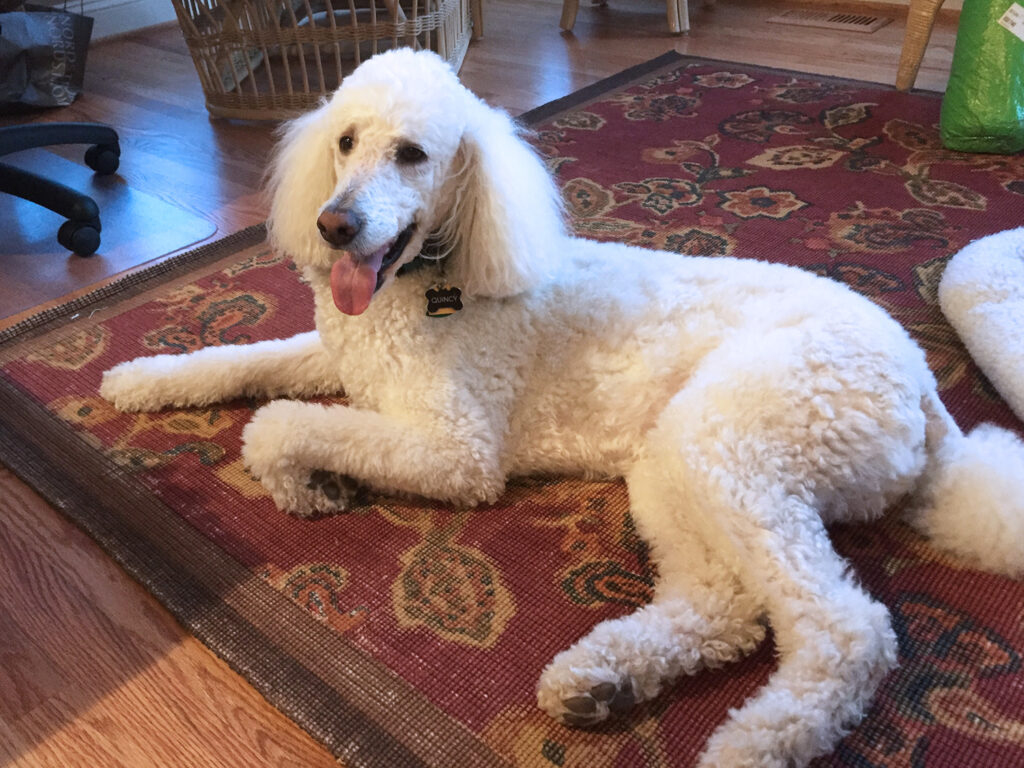Canine Chronicles with Quincy, a JSSA Therapy Dog – Vol. 1

When I first saw the ad in the Montgomery Gazette, I realized the potential of JSSA’s hospice volunteer program for pet therapy dogs. It would be a wonderful community service opportunity for me and my 2-year-old French poodle, Quincy, who is handsome, calm, and loves people. However, I wasn’t sure if I would be able to deal emotionally with people who were about to die.
I knew that a hospice patient is someone who has been diagnosed as terminally ill with a life expectancy of six months or less and has chosen not to receive curative care. What I didn’t know was that many hospice patients still have a lot of life and emotion left in them, but I was about to learn.
After I completed two days of training at JSSA, I took Quincy to People Animals Love (“PALs”) for his training. He wasn’t going to become a true service dog, but he had to learn to get along with other dogs and to be kind and gracious to patients in beds, walkers, and wheelchairs. Quincy passed his pet therapy dog training with flying colors and within a week we started volunteering at JSSA.
Visiting hospice patients with Quincy, a JSSA therapy dog
We had just two patients at first, but over the past three years, we have expanded our visits to about nine patients every Wednesday. I now understand that hospice patients are no different from other patients. They are interested in conversation, they have feelings, they value Quincy’s company and love to pet his soft fur. Others, in a more advanced stage, may just pet Quincy but not talk.
I try to read poems and stories to the patients. I’ll show them how Quincy can catch a ball in his mouth. With Quincy at their feet, we play Bingo, “Name that Tune,” “Fill In the Word,” and sing together. But mostly, we just talk, and I try to comfort and relax them.
Whenever I find a book or an article about military dogs or service dogs, I read it aloud to my alert patients. It may be the story of the Belgian Malinois, Mike, who detected thousands of pounds of explosives for U.S. special forces in Iraq, or Moxie, a black Labrador that alerts her diabetic owner to low blood sugar by smelling her breath, or Daisy and Tangle, who can detect the unique odor of bladder cancer cells in urine. There are so many other wonderful stories about dogs that my patients love to hear, and I try to read them all.
When one of my patients celebrated her 99th birthday with friends, volunteers from the facility, and volunteers from JSSA. Quincy and I attended the birthday party, told stories, and sang songs. A few months later, I attended her memorial celebration without Quincy because I thought it might be disrespectful to bring him. At the event, patient’s daughter told us about her mother’s life and loves. She told me about the two men in her mother’s later life. The first man befriended her in the facility and encouraged her to get out of bed and participate in many activities, and the second was Quincy! I realized what a mistake it had been to leave Quincy at home that day. At least she had seen Quincy and happily petted him shortly before she died.
A real connection and sharing
This experience has been incredibly rewarding for Quincy, for me, and for the patients. Through all of this, Quincy and I have learned that it’s not only what volunteers give to the patients, it’s also what the patients give to the volunteers.
About the Author: Richard D. Lieberman and his French Poodle, Quincy, are hospice volunteers at JSSA.
Interested in becoming a hospice volunteer? Click here to learn more!
